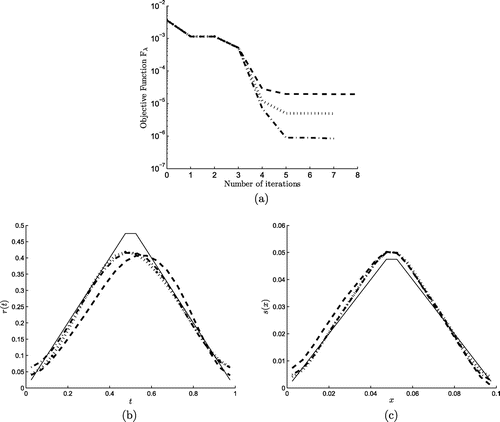Figures & data
Table 1. The RMSE (Equation5.1(5.1)
(5.1) ) and (Equation5.2
(5.2)
(5.2) ) for
and
, obtained using the BEM for the direct problem with
, for Example 1.
Figure 1. The analytical (—–) and numerical results for (a) and (b)
obtained using the BEM for the direct problem with
, for Example 1.
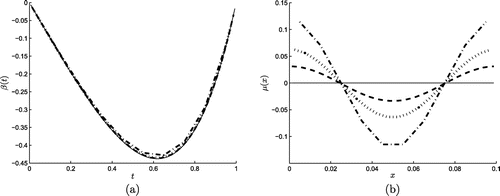
Figure 2. (a) The objective function and the numerical results for (b) r(t), (c) s(x), (d) u(0, t), (e) u(0.1, t) obtained with no regularization
, for exact data for Example 1. The corresponding analytical solutions are shown by continuous line (—–) in (b)–(e) and the
perturbed initial guesses are shown by dotted line
in (b) and (c).
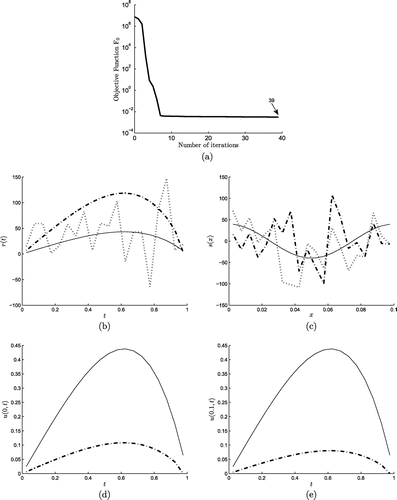
Figure 3. The numerical results for (a) r(t), (b) s(x), (c) u(0, t), (d) u(0.1, t) obtained with the first-order regularization and the second-order regularization
with regularization parameter
, for exact data for Example 1. The corresponding analytical solutions are shown by continuous line (—–).
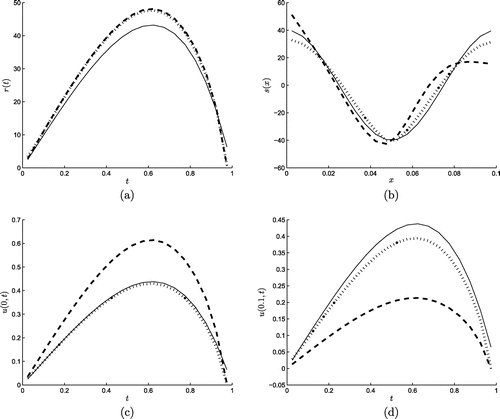
Table 2. The RMSE (Equation5.1(5.1)
(5.1) ) and (Equation5.2
(5.2)
(5.2) ) for
for exact data for Example 1.
Figure 4. (a) The L-curve criterion, (b) the objective function , and the numerical results
for (c) r(t), (d) s(x), (e) u(0, t), (f) u(0.1, t) obtained with the hybrid-order regularization (Equation5.12
(5.12)
(5.12) ) with regularization parameter
suggested by L-curve, for exact data for Example 1. The corresponding analytical solutions are shown by continuous line (—–) in (c)–(f).

Figure 5. (a) The objective function and the numerical results for (b) r(t), (c) s(x), (d) u(0, t), (e) u(0.1, t) obtained with the hybrid-order regularization (Equation5.12
(5.12)
(5.12) ) with regularization parameter
for
noisy data for Example 1. The corresponding analytical solutions are shown by continuous line (—–) in (b)–(e).

Figure 6. The analytical (—–) and numerical results for (a) and (b)
obtained using the BEM for the direct problem with
, for Example 2.
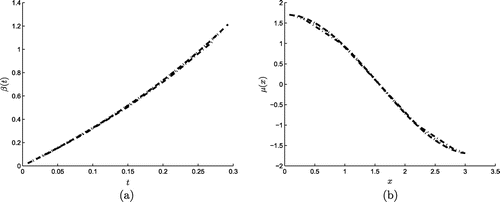
Table 3. The RMSEs (Equation5.1(5.1)
(5.1) ) and (Equation5.2
(5.2)
(5.2) ) for r(t) and s(x), for the noise levels
, for Example 2.
Figure 7. (a) The objective function , (b) the RMSEs (Equation5.1
(5.1)
(5.1) ) and (Equation5.2
(5.2)
(5.2) ) for
and
obtained with no regularization for exact data, and the numerical results for (c) r(t) and (d) s(x) obtained using the minimization process after 56 unfixed iterations
, and 31 fixed iterations
, for Example 2. The corresponding analytical solutions (Equation5.18
(5.18)
(5.18) ) are shown by continuous line (—–) in (c) and (d).
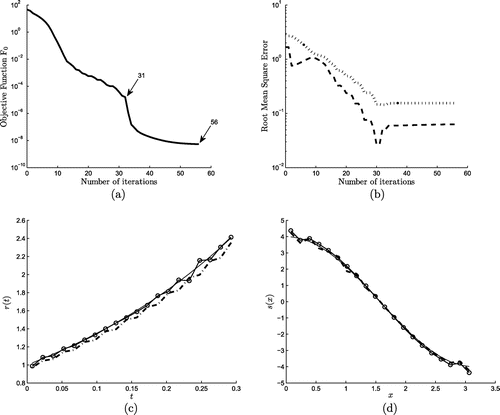
Figure 8. (a) The objective function , (b) the RMSEs (Equation5.1
(5.1)
(5.1) ) and (Equation5.2
(5.2)
(5.2) ) for
and
obtained using the hybrid-order regularization (Equation5.12
(5.12)
(5.12) ) with regularization parameter
for exact data, and the numerical results for (c) r(t) and (d) s(x) obtained using minimization process after 28 unfixed iterations
, and 23 fixed iterations
, for Example 2. The corresponding analytical solutions (Equation5.18
(5.18)
(5.18) ) are shown by continuous line (—–) in (c) and (d).
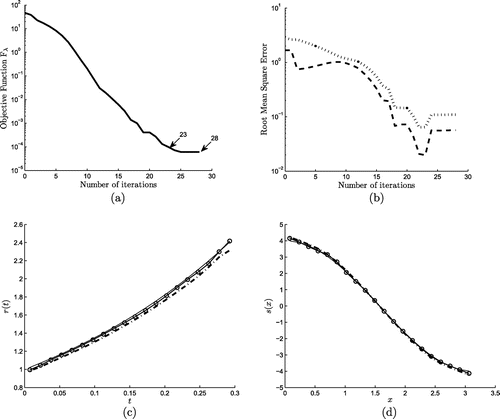
Figure 9. (a) The objective function , (b) the RMSEs (Equation5.1
(5.1)
(5.1) ) and (Equation5.2
(5.2)
(5.2) ) for
and
obtained using the hybrid-order regularization (Equation5.12
(5.12)
(5.12) ) with regularization parameter
for noise level
, and the numerical results for (c) r(t) and (d) s(x) obtained using the minimization process after 27 unfixed iterations
, and 21 fixed iterations
, for Example 2. The corresponding analytical solutions (Equation5.18
(5.18)
(5.18) ) are shown by continuous line (—–) in (c) and (d).
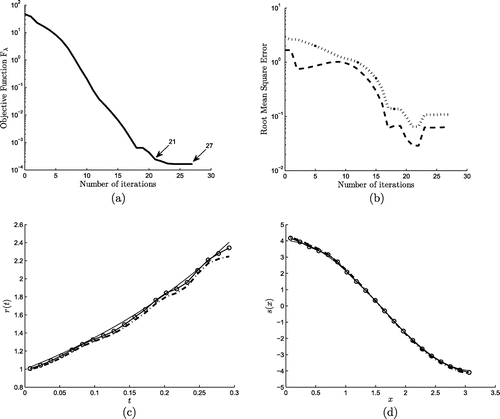
Figure 10. (a) The objective function , (b) the RMSEs (Equation5.1
(5.1)
(5.1) ) and (Equation5.2
(5.2)
(5.2) ) for
and
obtained using the hybrid-order regularization (Equation5.12
(5.12)
(5.12) ) with regularization parameter
for noise level
, and the numerical results
for (c) r(t) and (d) s(x) obtained using the minimization process after 17 (unfixed) iterations, for Example 2. The corresponding analytical solutions (Equation5.18
(5.18)
(5.18) ) are shown by continuous line (—–) in (c) and (d).

Figure 11. The numerical results for (a) and (b)
obtained using the BEM for the direct problem with
, for Example 3.
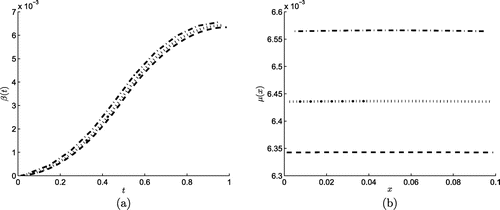
Figure 12. (a) The objective function and the numerical results for (b) r(t) and (c) s(x) obtained with the hybrid-order regularization (Equation5.12
(5.12)
(5.12) ) with regularization parameter
for
and
noisy data for Example 3. The corresponding analytical solutions (Equation5.21
(5.21)
(5.21) ) are shown by continuous line (—–) in (b) and (c).
